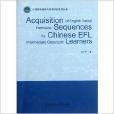《中國學習者對於英語動詞習慣性搭配的習得》根據知識特點將題目進行歸類,題型分類細緻、全面,精挑細選,對應性強,難易程度適中且有梯度,重難點突出,緊扣基礎,綜合提高,能力提升,培養學生綜合學習能力,根據中考考綱的要求,貼近高考,精講精析,真題演練,提前走進考場分析室,培養高考實戰能力。
基本介紹
- 書名:中國學習者對於英語動詞習慣性搭配的習得
- 作者:劉寧
- 出版日期:2012年7月1日
- 語種:英語
- ISBN:7564062614, 9787564062613
- 外文名:Acquistion of English Verbal Formulaic Sequences by Chinese EFL Intermediate Classrom Learners
- 出版社:北京理工大學出版社
- 頁數:156頁
- 開本:16
- 品牌:北京理工大學出版社
基本介紹,內容簡介,作者簡介,圖書目錄,
基本介紹
內容簡介
《中國學習者對於英語動詞習慣性搭配的習得》由北京理工大學出版社出版。
作者簡介
劉寧,1985年畢業於華中師範學院外語系英語語言文學專業,獲得文學學士學位。1987-1988年在清華大學高級教師進修班攻讀碩士研究生課程。1995年畢業於澳大利亞新南威爾斯大學英語系,獲得文學碩士學位。2012年畢業於英國西英格蘭大學人文學院語言系,獲得博士學位。1985年以來,一直在北京理工大學任教,先後發表論文10多篇,出版各類書籍10多部,研究方向主要是英語語言測試和二語習得。
圖書目錄
4.10 Summary of the Percentage of Correct Answers for the Items in Each Rank in the English Verbal Formulaic Sequences Post-test
4.11 Non-parametric K Related Friedman samples Test for Each of the Five Ranks on the Transparency/Opaqueness Scale of the English Verbal Formulaic Sequences Post-test
4.12 Summary of the Percentage of Correct Answers for the Items in Each Rank in the English Verbal Formulaic Sequences Training Test
4.13 Non-parametric K Related Friedman Test for Each of the Five Ranks on the Transparency/Opaqueness Scale of the VFS Training Test
4.14 Summary of the Mean Scores and Mean Ranks of the Five Groups of English Verbal Formulaic Sequences in the Three English Verbal Formulaic Sequences Tests
Figures
2.1 Model of Speech Production
2.2 The Lexical Space: Dimensions of Word Knowledge and Ability
4.2.3.4 Increase in the Mastery of English Verbal
4.3 Relationship Between Vocabulary Size and the Mastery of English Verbal Formulaic Sequences
4.4 Relationship Between Overall English Proficiency and the Mastery of English Verbal Formulaic Sequences
4.5 Relationship Between the Semantic Transparency and the Mastery of English Verbal Formulaic Sequences
4.6 Relationship Between Input Frequency and the Mastery of English Verbal Formulaic Sequences
4.6.1 Textbooklnput Frequency and the Mastery of English Verbal Formulaic Sequences
4.6.2 Explicit Classroom Instructions and the Mastery of English Verbal Formulaic Sequences
4.7 Relationship Between the Participants'General Vocabulary Knowledge and the Mastery of English Verbal Formulaic Sequences
Chapter Five:Findings and Discussion
5.1 Major Findings
5.2 Discussion
5.3 Limitations
APPENDICES
Appendix Ⅰ: The 50 Most Frequent Verbs of the English Language
Appendix Ⅱ: The Top-10 Verbs with Their Instances in College English Curriculum Requirements (CECR)
Appendix Ⅲ: The 100 Target English Verbal Formulaic Sequences
Appendix Ⅳ: The Final 100 Target English Verbal Formulaic Sequences in Sentence-length Contexts
Appendix Ⅴ: The English Verbal Formulaic Sequences Pre-test and Post-test
Appendix Ⅵ: The English Verbal Formulaic Sequences Training Test
Appendix Ⅶ: The Vocabulary-size Pre-test and Post-test
Appendix Ⅷ: The Questionnaire
Appendix Ⅸ: The Transparency/Opaqueness Survey of the 100 Target English Verbal Formulaic Sequences
Appendix Ⅹ: The Textbook Input Frequency of the 100 Target English Verbal Formulaic Sequences
References
4.11 Non-parametric K Related Friedman samples Test for Each of the Five Ranks on the Transparency/Opaqueness Scale of the English Verbal Formulaic Sequences Post-test
4.12 Summary of the Percentage of Correct Answers for the Items in Each Rank in the English Verbal Formulaic Sequences Training Test
4.13 Non-parametric K Related Friedman Test for Each of the Five Ranks on the Transparency/Opaqueness Scale of the VFS Training Test
4.14 Summary of the Mean Scores and Mean Ranks of the Five Groups of English Verbal Formulaic Sequences in the Three English Verbal Formulaic Sequences Tests
Figures
2.1 Model of Speech Production
2.2 The Lexical Space: Dimensions of Word Knowledge and Ability
4.2.3.4 Increase in the Mastery of English Verbal
4.3 Relationship Between Vocabulary Size and the Mastery of English Verbal Formulaic Sequences
4.4 Relationship Between Overall English Proficiency and the Mastery of English Verbal Formulaic Sequences
4.5 Relationship Between the Semantic Transparency and the Mastery of English Verbal Formulaic Sequences
4.6 Relationship Between Input Frequency and the Mastery of English Verbal Formulaic Sequences
4.6.1 Textbooklnput Frequency and the Mastery of English Verbal Formulaic Sequences
4.6.2 Explicit Classroom Instructions and the Mastery of English Verbal Formulaic Sequences
4.7 Relationship Between the Participants'General Vocabulary Knowledge and the Mastery of English Verbal Formulaic Sequences
Chapter Five:Findings and Discussion
5.1 Major Findings
5.2 Discussion
5.3 Limitations
APPENDICES
Appendix Ⅰ: The 50 Most Frequent Verbs of the English Language
Appendix Ⅱ: The Top-10 Verbs with Their Instances in College English Curriculum Requirements (CECR)
Appendix Ⅲ: The 100 Target English Verbal Formulaic Sequences
Appendix Ⅳ: The Final 100 Target English Verbal Formulaic Sequences in Sentence-length Contexts
Appendix Ⅴ: The English Verbal Formulaic Sequences Pre-test and Post-test
Appendix Ⅵ: The English Verbal Formulaic Sequences Training Test
Appendix Ⅶ: The Vocabulary-size Pre-test and Post-test
Appendix Ⅷ: The Questionnaire
Appendix Ⅸ: The Transparency/Opaqueness Survey of the 100 Target English Verbal Formulaic Sequences
Appendix Ⅹ: The Textbook Input Frequency of the 100 Target English Verbal Formulaic Sequences
References

